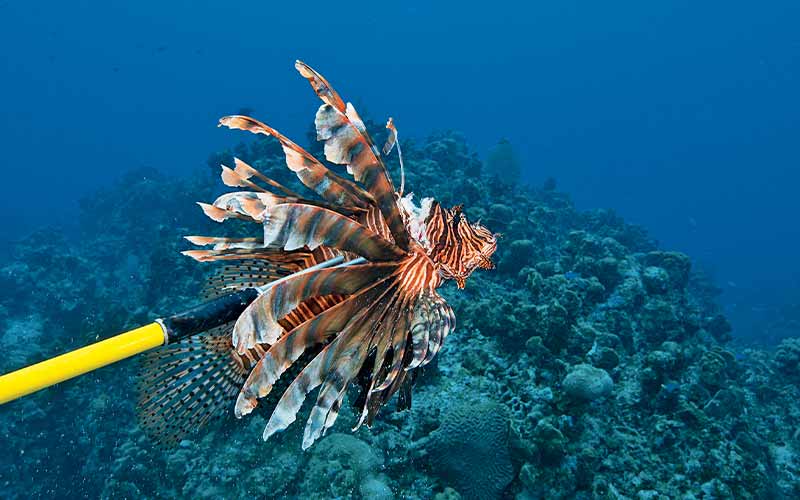It was 11 a.m. on Sunday, Nov. 10, 2013, and we were doing our second dive of the day. We were diving in 30 to 50 feet of water off the shore of Eleuthera in the Bahamas. Tony and Art were spearing invasive lionfish for a meal on the boat and had already collected 10 of them. The coral formations resembled giant mushrooms, and lionfish could be found in the spaces underneath.
Art had just speared two lionfish and was heading back to the boat when he attracted the attention of a couple of 3- to 5-foot-long Caribbean reef sharks. They were drawn by the fish blood and dying movements of the fish on the end of the spear. One shark swam up under Art as he made his way toward the boat. As the shark opened its mouth and headed toward the fish, he encountered Art’s left hand instead. Art says it was sudden, unexpected and painful. He tucked his fist under his right armpit and continued to the boat, where he handed up his fish. Sue and Paula then helped him aboard, applied a pressure dressing and helped him remove his suit. There was a lot of blood. Art doesn’t remember any of this.
Capt. Dan called Divers Alert Network® (DAN®) to report the injury. The DAN medic asked Capt. Dan to stay on the line and, in short order, relayed evacuation details to him. DAN made all the arrangements; just like that, an evacuation for Art and me was under way.
When I got back on board the boat, my job was to gather our passports, money, credit cards, clothing and medications to take with us on the flight to Florida.
Capt. Dan took us to a small harbor on Eleuthera. Our fellow divers and the crew accompanied us to shore to see us off. The local ambulance, with siren blaring, took us to meet our flight after a short stop at the local medical clinic, where Art got a tetanus shot.
The crew of the Trinity Air Ambulance jet was waiting for us at the airport. They quickly got us on board and the aircraft ready for takeoff, which happened almost immediately. The pilot informed us that the cabin was pressurized to sea level, which was important as it hadn’t been long since we’d surfaced from our last dive. The flight took about 45 minutes, during which time the paramedics assessed Art’s condition and answered many questions.
We landed in Fort Lauderdale, where we went quickly through customs and were loaded into another ambulance and transported to the emergency department at St. Mary’s Medical Center in West Palm Beach. There Art saw doctors, nurses and other hospital personnel and soon went into surgery to repair his hand. By 8 p.m. he was comfortably settled in his bed. We were treated with kindness and professionalism by the hospital’s staff.
DAN’s efficiency and the speed with which they accomplished everything were truly remarkable.
I spent the night in a chair by Art’s bed (oh, my aching back!) and checked into a nearby hotel for a bit of sleep and a shower the next day. After three days Art was released to fly home. DAN took care of everything. Of all the lessons we learned that day, the most valuable was: Don’t ever dive without DAN.
Hazardous Conditioning
By Serena Hackerott
If you’ve had a pet, you’ve probably experienced it rushing toward you expectantly when you open a can or shake a bag that sounds like its food. Your pet learned to associate that sound with being fed, even if the sound was actually just a can of vegetables or a bag of chips. Similarly, some divers around the Caribbean have fed dead or wounded lionfish to sharks and other native predators so often that these fish have begun to associate divers — especially those spearing lionfish — with food. Unfortunately, the consequence is greater than a pet’s persistent bark or meow: Divers may be injured by native predators expecting food. Although there have been reports of Caribbean predators eating lionfish, our research found that lionfish populations are not controlled by native predators in the Carribean.1,2

I think it’s very dangerous to try to teach native predators to eat lionfish. I’ve been a diver for more than 10 years and have never felt threatened by a shark. I might not feel so comfortable, though, if sharks began to expect snacks every time I enter the water.
There’s no scientific evidence that native predators will learn to eat lionfish enough to reduce their numbers. The only method we currently have to control the lionfish population is removing them from reefs, so it’s important that this practice can continue safely. I’ve speared hundreds of lionfish without incident.
I hope the diving community begins to discourage feeding lionfish to native predators so that spearing lionfish remains a safe activity. Instead of feeding lionfish to sharks, try eating them yourself. My colleagues in the Bruno lab at the University of North Carolina and I have eaten almost as many lionfish as we’ve speared. Lionfish taste just like snapper or grouper, and the knowledge that you are helping the reefs might make them taste even better.
References
- Hackerott S, et al. Native predators do not influence invasion success of Pacific lionfish on Caribbean reefs. PLoS ONE 8, e68259 (2013).
- Valdivia A, Bruno JF, Cox CE, Hackerott S, Green SJ. Re-examining the relationship between invasive lionfish and native grouper in the Caribbean. PeerJ 2, e348 (2014).
© Alert Diver — Q3 Summer 2014